

| Glow Worms - a detailed summary 2011 |
| In four years monitoring this Glow Worm colony, the one and only guaranteed certainty is that when you think you can predict a seasons events in advance, this beetle makes you reconsider pretty much everything you thought you knew. There's also the "don't believe everything most books say" factor to account for. Many insect books generalise information and the only real way to find out anything, is to find it out for yourself. | ||
| .... | ||
| Of course this often takes many
hours out in the field and when studying Glow Worms, this
means that the hours in the field are usually extremely
unsociable hours. Yet the magical attribute of this
beetle's ability to produce light, can bring together
people from different areas and backgrounds, which meant
that during the Spring and Summer, we had a regular
string of visitors to help us with our continuing study. Glow Worms are still in national decline, disappearing from many of their former haunts through a series of influencing factors and is probably as deserving as having nationally notable B status as some that already do. It's importance as part of our native fauna then, is perhaps not in its rarity value, but as a public relations excercise, helping to create a greater awareness of our native fauna in both young and old. |
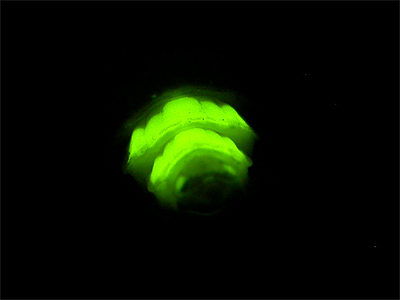 |
|
| .... | ||
| This years public Glow Worm walk around the Sherwood Forest CP and then Clipstone Old Quarter was again very well attended. These walks are very popular with both adults and accompanied children, as was this years walk held on June 25th. Although a good few Glow Worms were seen by the group, the date initially gave us cause for concern, as 2011 turned out to be an early year for many invertebrates. In the end, June 25th actually coincided with another large emergence of females, of which there had already been several instances of, in what was another record breaking year. | ||
| .... | ||
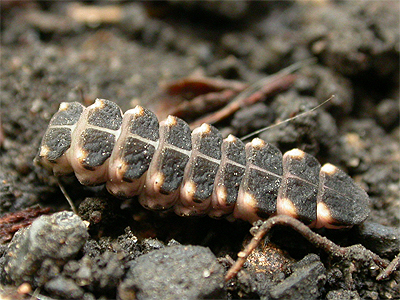 |
However, we start this
year's summary by looking at the record numbers of larvae
found in the early Spring. We must point out now, that
there are numerous tables and graphs (approximately 61)
complementing this summary, allowing much easier
comparison between larval, male and female data from
2009, 2010 and 2011 glowing seasons. Early Spring larval survey results and data Once again, only sections A, B, C and D of the area were surveyed for larvae, by early May revealing a total of 231 larvae. The surveys produced a very surprising set of results, with early numbers well up on both previous years larval surveys. We had actually expected a poor year generally for numbers, based on the assumed two year larval stage and after having increased numbers of adults in 2010. With the extremely cold period of weather in late November and throughout the whole of December 2010, it was always uncertain how successful larval over-wintering would be, but after the last of the remaining snow melted in early January, the remainder of the Winter became relatively mild and dry. |
|
| .... | ||
| March continued the dry theme and it soon became obvious that it was worth an earlier start to our surveys for larvae. This immediately proved successful and produced good numbers of larvae within the two smaller size ranges. Larval growth in late March and through April is clearly shown by the differing ratios of 12-16mm (red) larvae to 17-21mm larvae (blue) in the larval sizes table for 2011 produced below. Notable in 2011 is the high number of 17-21mm range larvae, compared to both previous years. Apart from the much higher numbers, the ratio differences between the four larval sizes ranges in 2011 and both 2009 and 2010 are staggeringly contrasting, yet the number of larvae found in both larger size ranges, was surprisingly similar to both previous years. | ||
| .... | ||
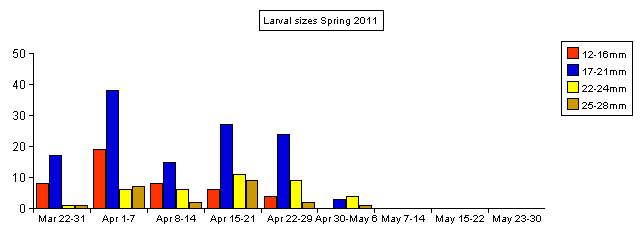 |
||
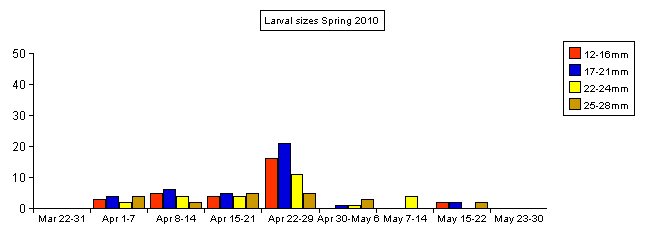 |
||
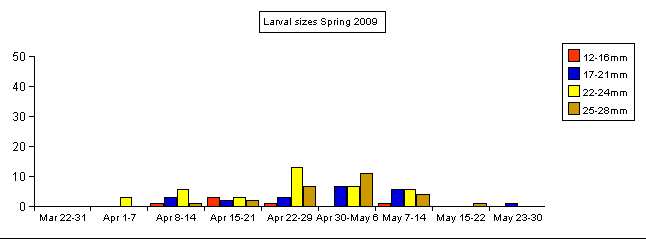 |
| ........ | ||
| Signs that the glowing season may begin early this year, came with the high numbers of larvae found during late March, but the number of larvae in the full grown category (25-28mm) remained low throughout the course of the Spring. New record counts were reached on several dates, ultimately peaking at 22 larvae on April 5th. But double figure counts were also achieved on seven seperate dates, a feat only achieved twice before in previous years. | ||
| ........ |
| The two graphs below show the larval numbers found within sections A, B, C and D in 2011 and 2010, but remember that when making direct comparisons between the two graphs, there is an additional earlier week in the 2011 graph. It is obvious that there were huge differences in the number of larva from section D to the other three sections surveyed. Section C provided very few larvae for all of the six weeks we spent surveying this year, whilst there was a general increase in the number of larvae found in section B. |
| ........ |
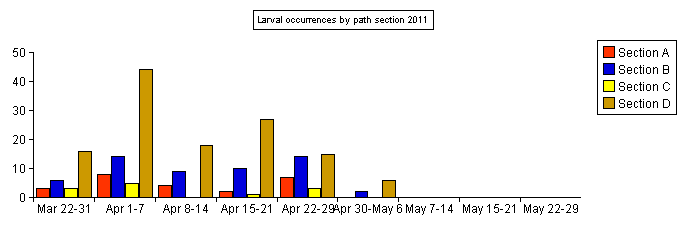 |
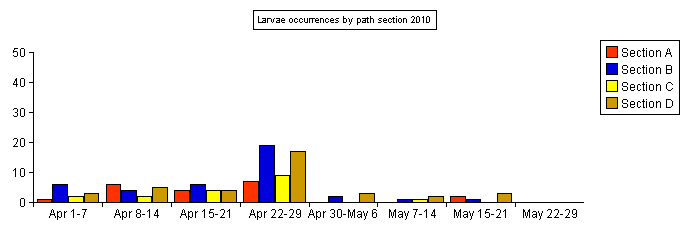 |
| ........ | ||
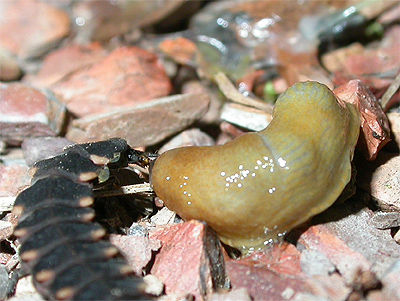 |
By the end of April, we
began to notice a drop in numbers. This was thought to be
directly linked to the very warm and dry conditions
experienced throughout most of the period and
consequently low numbers of prey items. As the path
became drier, larval numbers dropped and very few were
ever recorded in the middle of the path. Most records
came from along one edge of the path with the most
vegetation growing alongside. Several visits were also made to check for larvae during the morning, while the path was still largely in shade. This was successful on each visit, usually providing better counts than those that had been achieved the evening before. This could have been down to the slight increase in moisture levels from any overnight dew, but may also have been down to the slightly lower temperature in the morning than in the late evening. Larvae found on the path during the evening, were not all at the pre-pupation stage, although we believe that those found during the morning probably were (judging by their generally larger size). Several instances of active hunting were again observed along the surveyed path over the course of the Spring, illustrated in the left hand photograph. |
|
| ........ | ||
| Female
Glow Worm survey results and data The very early flight periods of many invertebrates locally, made it worth surveying for the first females much earlier in 2011 than we did in 2010. Starting our first survey on May 7th, the first three females all appeared nearly a week later on May 13th, about 14 days earlier than the previous year. This 14 day early period, remained pretty much applicable to much of the female data throughout the course of the glowing season, but there was nothing similar in terms of adult totals. |
||
| ........ | ||
| By the middle of August,
a quite staggering total of 792 females had been counted
and their positions all marked by labels. A total of
approximately 100 males were found with females this
year, but males will be dealt in more detail later. An addition to the colony surveying in 2011, was the recording of the ground temperature from two seperate locations. The two locations were chosen on paths at the lowest and highest points of the site. On most evenings when the sky was clear and there was little or no wind, both locations gave quite contrasting temperatures. Further work on the number of glowing females and corresponding temperatures, may well be undertaken in 2012, by taking additional temperatures from the highest and lowest points in the grass strip. A trial evening doing this provided ground temperatures of 12°C and 11°C from the two path locations, with a grass temperature of 8°C. |
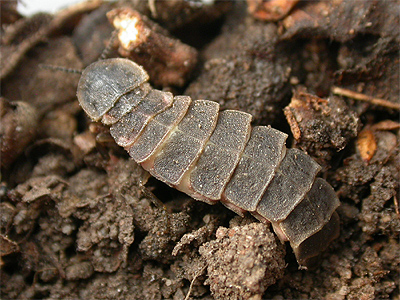 |
|
| ........ | ||
| 8°C proved to be a real factor during the season, found on every occasion to provide very low numbers of females. Evenings with low ground level temperatures, are clearly seen in the first of the following three graphs. The graphs show the daily/nightly female counts throughout 2011 (top), the number of new females per night and at the bottom, the number of females (in blue) and the corresponding maximum temperature (in red) from one of two locations where the temperature was taken. | ||
 |
||
 |
||
 |
| .... | ||
| The
temperature often ranged considerably, with a low of 7°C
on May 19th and a maximum of 22°C on August 1st. As can
be seen from the graph immediately above, there was a
gradual rise in the evening temperature from mid-May to
early August. An arial map showing the survey areas on site is produced below. The usual survey route taken was area O, R, L, M, N, P, K, J, F, G, H, I, D, E, C, B and finishing in A, but on a few occasions this year, we reversed the route order. The two yellow dots marked T1 and T2, indicate the on site locations of ground temperature measurements, with T2 being the highest of the two points. The central grid reference is SK 60549 67012. |
||
| .... |
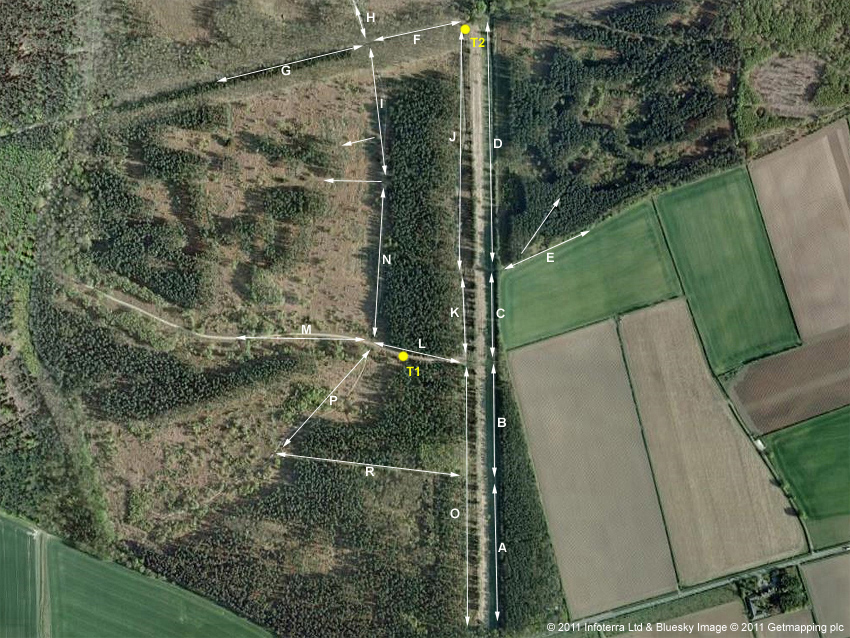 |
||
| ..... | ||
| The dry Spring continued throughout the season and surveys for adults were carried out on a total of 102 site visits, with some rain during the day or evening on just 22 of these dates. The table below shows the dates and weather conditions of the largest (more than 20) female emergences during 2011. | ||
| ..... |
| Females | Temperature | Weather | |||||||
| Date | Total | New | T1 | T2 | Clear | Rain | Cloudy | ||
| ..... | ..... | ..... | . | ..... | ..... | . | ..... | ||
| 04/06/11 | 26 | 23 | 12°C | 12°C | Cloudy and mild | ||||
| 05/06/11 | 28 | 21 | 11°C | 11°C | Cloudy and mild with occasional light drizzle | ||||
| 09/06/11 | 55 | 47 | 12°C | 12.5°C | Overcast and mild | ||||
| 12/06/11 | 88 | 50 | 12°C | 12°C | Dry, warm and breezy after heavy rain until mid-evening | ||||
| 14/06/11 | 36 | 24 | 12°C | 13°C | Clear and mild | ||||
| 15/06/11 | 35 | 22 | 14°C | 15°C | Clear and mild | ||||
| 20/06/11 | 50 | 37 | 13°C | 14°C | Cloudy and mild with rain most of the evening | ||||
| 24/06/11 | 27 | 20 | 9°C | 10°C | Cloudy and mild with rain | ||||
| 25/06/11 | 57 | 47 | 13°C | 14°C | Clear and warm | ||||
| 26/06/11 | 42 | 35 | 17°C | 19°C | Clear and very warm | ||||
| 27/06/11 | 42 | 36 | 19°C | 18°C | Clear and very warm | ||||
| 01/07/11 | 35 | 20 | 13°C | 13°C | Clear and warm | ||||
| Once again, there was a sudden large emergence of females in the second week of June, with 50 new females (out of a total of 88) on June 12th 2011. 82% of these females were found in section D. This was especially interesting, as it was extraordinarily similar to a large emergence of two years ago, when 63 females emerged (out of an 85 total) on June 8th 2009 and to a smaller emergence of 21 new females out of a total of 35 on June 12th 2010. Numbers of females present over several nights prior to all three of the dates was much lower and on each occasion these large emergences have caught us by surprise. |
| .... | ||
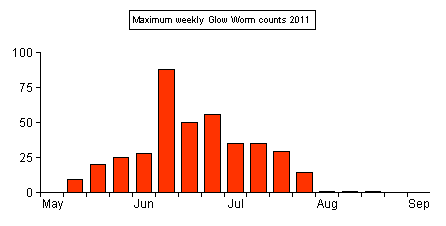 |
When these sort of
emergences occur, there is a strong tendency for us to be
too busy recording and marking the number of females to
enjoy it properly. So this year, we actually took a few
minutes out to really appreciate seeing the numbers we
had in the top half of section D on June 12th. Heavy rain
till mid-evening had clearly not put them off from
glowing. This emergence came after the two previous nights yielded counts of just three and four respectively. Both these evenings were cool with temperatures of 7°C (T1) and 8°C (T2). It is of course entirely possible that the 50 new females had hatched out over the course of June 10th, 11th and 12th and glowed for the first time when the temperature rose on June 12th but this is rather hypothetical and there is no evidence of this happening. |
|
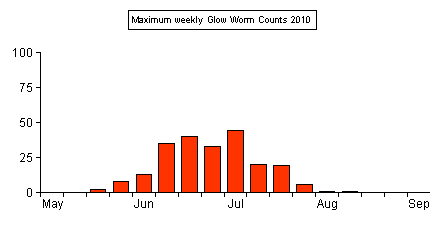 |
Whatever the explanation,
these early large emergences have all occured around two
weeks before the average seasonal peak in female numbers
in the last week of June or the first week of July. This
is probably not an event restricted to the Glow Worm, but
may also be evident in the populations of other
invertebrates. This average peak is well shown in the following four graphs on the left of this text, showing the maximum weekly female counts from 2008 - 2011. The lack of daily coverage in 2008, probably renders that graph obsolete and is included here, only because it does illustrate the average seasonal peak. Apart from the sheer numbers of females, 2011 was exceptional in the length of the season, lasting for 14 weeks. |
|
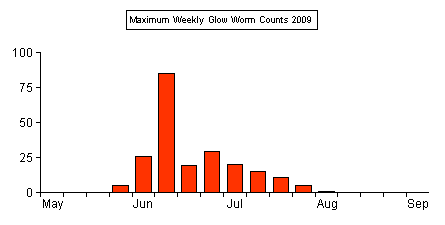 |
This was in part due to
the very late appearence of Female 792 on August 5th and
remaining until August 21st. In a way, this female threw
the sequence of latest emergence dates we have recorded
out of sync, with the three previous years providing
dates around July 18th - 22nd. August 21st finally marked the end of the season, although we did continue to make site surveys checking for other late emergences for a few days after that, but primarily the very early start to the season on May 13th, was certainly weather related. It is known that many other Glow Worm sites across the UK, are rarely checked much before June and even some sites in the very south of the UK, don't actually become 'active' until about that time. At least that is what is presumed or is evident through records sent to the UK Glow Worm Survey run by Robin Scagell. |
|
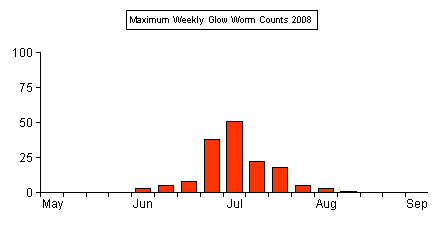 |
It is interesting to
suppose why Clipstone Old Quarter has produced such early
records for the past two years, when traditionally, there
has always been about a 14 day delay in the first records
of many invertebrates from sites south of the Thames,
compared to those from Nottinghamshire. The reason for this has always been climatic rather than anything else, with temperatures across the southern UK, always being a degree or so warmer than those in Nottinghamshire. We personally think that our early Glow Worm records are just down to consistant early coverage and that the glowing season is just as early at many sites south of Nottinghamshire. |
|
| .... | ||
| The facts and figures for females recorded
on either one, or two and three consecutive dates only,
again make for interesting comparison. At the start of
this summary, we mentioned about how unpredictable Glow
Worms are and this certainly proved to be the case. It's quite difficult to discern any real single peak in Table 01 for 2011. If the percentages in Table 01 and Table 01a are compared, note how it is May 25-June 1st 2011 and June 17-18th 2010 before 80% is reached. This shows that males appeared much earlier in 2011 than they did in 2010, but in similar fashion to 2009. There was then a drop in the number of males found with females, before a sudden rise and peak in numbers on June 12th and 13th. On these dates, we recorded 92% of females being mated on the first night. June 12th also coincided with the emergence of 50 females out of a count of 88 females, but numbers of males remained surprisingly low for a further few days. |
||
| .... |
|
|
|||||||||||||||||||||||||||||||||||||||||||||||||||||||||||||||||||||||||||||||||||||||||||||||||||||||||||||||||||||||||
| .... | ||||||||||||||||||||||||||||||||||||||||||||||||||||||||||||||||||||||||||||||||||||||||||||||||||||||||||||||||||||||||||
| The data in the 2010 table (Table 01a)
showed a gradual rise, a general clear peak and drops in
the percentages of females glowing for one night. 2011
was entirely different. It is interesting to note that in
2009, the percentage of females appearing for one night
peaked at just 72% between June 13th and Jun 20th. Tables 02 and 02a show the figures for females glowing for two consecutive evenings/nights. There is a big jump from 2% - 22% of females glowing for two consecutive evenings only from Jun 12th, before the figures drop back down again. Where in 2010 the percentage of females glowing for two dates gradually lowered from 30% at the start of the season, then rose again near the end, the percentages in Table 02, again show a very mixed set of results. The only factor that could possibly account for this, was that there must have been several good emergences of males between mid-May and the end of June 2011. |
||||||||||||||||||||||||||||||||||||||||||||||||||||||||||||||||||||||||||||||||||||||||||||||||||||||||||||||||||||||||||
| .... | ||||||||||||||||||||||||||||||||||||||||||||||||||||||||||||||||||||||||||||||||||||||||||||||||||||||||||||||||||||||||||
|
|
|||||||||||||||||||||||||||||||||||||||||||||||||||||||||||||||||||||||||||||||||||||||||||||||||||||||||||||||||||||||||
| .... | ||||||||||||||||||||||||||||||||||||||||||||||||||||||||||||||||||||||||||||||||||||||||||||||||||||||||||||||||||||||||||
|
|
|||||||||||||||||||||||||||||||||||||||||||||||||||||||||||||||||||||||||||||||||||||||||||||||||||||||||||||||||||||||||
| .... | ||||||||||||||||||||||||||||||||||||||||||||||||||||||||||||||||||||||||||||||||||||||||||||||||||||||||||||||||||||||||||
| Male Glow Worms - results and data for 2011 and comparisons with previous years | ||
| .... | ||
| Estimating or counting
the number of males on site is impossible and we realised
this year that we actually only ever record a small
percentage of males on site throughout the season. To
test this we used artificial lures, made for us by fellow
Glow Worm enthusiast Martin Dale. Artificial lures have been used with effect at other UK sites, and are an easy way of determining the presence of Glow Worms by attracting males. They use a small battery powered LED light that can be placed on the ground, or preferably in light grass and their efficiency as an attractant is excellent. The number of males present on site on June 3rd, was highlighted by an hour long experiment using two artificial lures in close proximity (of two types and at different heights) to attract males. One lure placed directly on the ground in light grass, had attracted a total of 17 males by 23:45h, but the other attracted none. Bearing in mind that just six females were present during our survey of June 3rd, it shows how the number of males present on site, is considerably underestimated. |
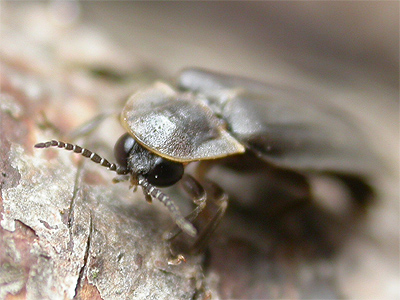 |
|
| .... | ||
| A great deal of work has been done on Glow Worms by John Horne at his nature reserve near Southampton. He has found that males over a certain weight do not fly until their fat reserves gained during the larval stage drops to a certain level. Until this level is reached, many males will walk in their search for a female. This might explain the lack of males attending the higher lure. | ||
| .... | ||
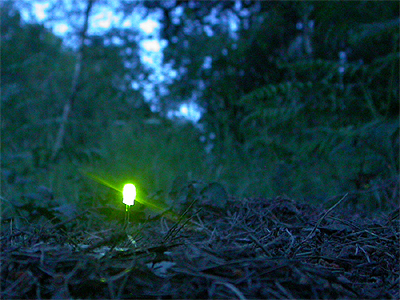 |
A general lack of flight
in larger (heavier) males could help to explain why some
females in any given area continue to remain unmated,
even when glowing brightly in an open situation, yet
other females appearing a metre or two away (sometimes in
heavy cover) can be mated on night one. This is something
we have noticed many times over the last three years and
it seems likely that there is still some use of
pheremones in females. The visible brief glow males produce, is something else we have noticed. It is always very difficult to detect and usually has to be corroborated by at least two observers to be recorded as genuine. These brief flashes are usually close to the ground at about grass height, but males do produce a more persistant very faint glow, if viewed in darkness from underneath. We only used lures to attract males on isolated occasions, so that survey results were not affected. Among the benefits of using lures in the future, is that they could provide information on the height at which males fly, or how large an area they cover outside the colony boundaries. |
|
| .... | ||
| Initial work
on the flight temperature, suggests that it needs to be
above 8°C, as the few trials completed using the lures
at lower temperatures attracted no males at all, even
when run at ground level in a sunken pot. 100 males were recorded with females this year, with the first male appearing on May 17th after the first females on May 13th. This was very early, but probably not that unusual. Although our work has confirmed that males have a much shorter season than females, it's not unknown for males to appear more or less at the same time as the earliest females. The next three graphs below show the numbers of females and the total number of males found in cop with females between 2009 and 2011. |
||
| .... | ||
 |
||
 |
||
 |
||
| .... | ||
| Early males
were recorded in both 2009 and 2011, but then there was
generally a 10-12 day gap in male records till they began
to be recorded more consistantly throughout June and into
early July. When the female data is removed from the
graphs, the records of males is shown more clearly. We
have only used the number of males actually found with
females to produce the graphs below and this applies to
all three, so the data is consistant from year to year. Male records were rather erratic overall in 2011, but do seem to show several peaks of activity. Just one male was recorded with a female after the first week of July this year, similar to the record for the corresponding month in 2009. Females found with two males were F091 F106 F331 F527 F566 and F641, whilst three males were recorded with F348 and F567. The number of males in 2010 was actually greater, when there was a prolonged peak from the middle of June and into early July. In 2009, the activity level and numbers involved was much lower, but the length of the male season is virtually the same as in 2010. |
||
| .... | ||
 |
||
 |
||
 |
||
| .... |
| Whilst the
lack of male sightings during July is very interesting,
many females are obviously still mated. So does the lack
of males recorded during our survey times after early
July, perhaps mean that mating occurs later in the night?
We usually arrive on site and start surveying from dusk.
In May this roughly equates to a 21:40h start time,
finishing around 23:40h. With the shorter nights and an
increase in the number of females to record in June,
survey start and end times are around 22:00h and 00:20h,
though the end time can vary considerably. Overcast
conditions sometimes allow for a slightly earlier start,
depending on date. On several occasions this year, we returned and conducted second surveys that lasted well into the early morning hours. These were to help determine how long females glow for. Though the number of return visits was not enough to gather any useful data, we did find that quite often, females unmated for any length of time (more than a week) would continue to glow till around 01:00h and occasionally 02:30h, though this was dependent on weather conditions and date. Females that had glowed for the first time during the initial survey that evening, were all found to have stopped glowing completely by the time we returned on site. Where it was practical to do so, we also got into the habit of re-checking some survey sections an hour later, to see if females which were not glowing the first time, had started glowing by the time we checked again. This worked on many occasions, especially during the latter part of the season, but we still found it puzzling as to why females seemingly failed to glow when conditions seemed ideal. Checking the same female twice sometimes worked the other way - glowing when first checked, but not later. Sometimes females went 'missing' not glowing for three or four nights, then would reappear again. But we did have at least two instances where females failed to glow (or be found) for five nights, before appearing again in their usual location. Female 792 would later give us more of an insight into their glowing tendencies when she was taken into captivity. |
||
| .... |
|
|
|||||||||||||||||||||||||||||||||||||||||||||||||||||||||||||||||||||||||||||||||||||||||||||||||||||||||||||||||||||||||
| .... | ||||||||||||||||||||||||||||||||||||||||||||||||||||||||||||||||||||||||||||||||||||||||||||||||||||||||||||||||||||||||||
| We also recorded several instances where
females known to be present in the grass areas of
sections A, B, C and D, (sometimes well over 20 females)
failed to glow at all for one, two and in one instance,
three consecutive evenings, yet all would reappear on the
same date. It became clear to us that females glowing
from locations along path edges, were usually far more
consistant in glowing, especially if the evening was wet
and slightly cool. It was strange that numbers of females
in the grass, sometimes failed to glow (at least openly)
even when it was dry and more than warm enough. Tables 04 and 04a show the average glowing periods of all females recorded during 2011 (792f) and 2010 (502f). The data from groups of 50 females is used and their inclusive dates are given. The average number of dates females glowed for in 2011 varied, although the pattern of a higher average, becoming shorter in peak season, then increasing again is clear. Further notes and summaries of Glow Worm activity in survey sections A - R Below is the arial map showing the female locations plotted as red dots and survey sections as white directional arrows during 2011. The yellow directional arrows show the movement of Glow Worms into areas of the site where adults had not been recorded previously. The central grid reference is SK 60549 67012. |
||||||||||||||||||||||||||||||||||||||||||||||||||||||||||||||||||||||||||||||||||||||||||||||||||||||||||||||||||||||||||
| .... | ||||||||||||||||||||||||||||||||||||||||||||||||||||||||||||||||||||||||||||||||||||||||||||||||||||||||||||||||||||||||||
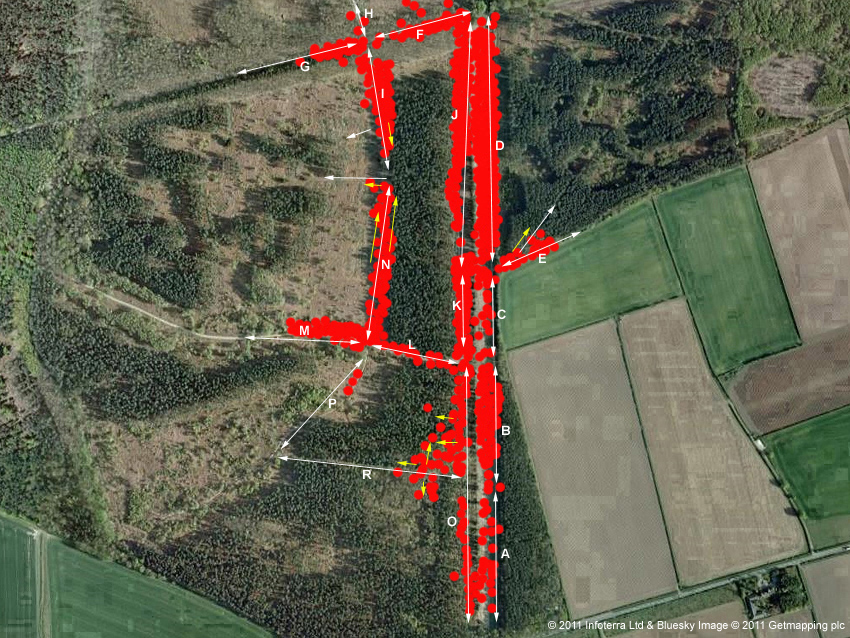 |
| .... |
| 2011 again showed how the various survey sections of the site would become active or inactive at different times throughout the glowing season. Breaking this down even further, it was noticeable that even particular areas within a survey section could become active on different dates. This was perhaps most noticable in section D, in which the top most third of this section produced many females first, with females gradually appearing further down the grass over the next few evenings, although few females were recorded in the lowest part of section D. | ||
| .... | ||
| As the above arial
photograph shows, Glow Worms showed an increase in range
into several previously unrecorded areas. The two most
obvious movements occurred in section N and section R.
The habitats of these two sections are both very
different. Section N (photographed on the right) is a minor forest path, south-facing and although open to any weather approaching from the west and shaded for part of the morning, is still probably one of the warmest sections on site. Vegetation either side of the path is short grass with some Bracken. Formerly bordered on both sides by Pine plantations, one side was clear-felled years ago and is now being restored to heathland. Glow Worms first appeared in this section in 2009, when small numbers were concentrated at the southern end of section N, despite the whole length of section N being walked over many times. 2010 saw records increase in both number and distance away from the original source, but the number of records in 2011, saw the whole of this section producing females for the first time. |
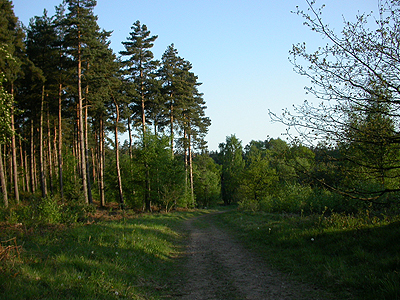 |
|
| .... | ||
| Small numbers
of female Glow Worms were found in section R for the
first time last year. It was not an area that we had
covered with any regularity before and during the 2011
season, many females were found well under the tree
canopy, in shaded areas with Bracken and Bramble. Good
numbers of females emerged in section R and the general
area of where section R meets up with section O on June
26th. The following tables show (and allow direct comparison) the numbers of new females recorded each week in sections A - R during 2011 and 2010. Each section is accompanied by a short summary. |
||
| .... | ||
| Section A - Grass (sunny, flat aspect) | Section B - Grass (sunny, north-facing) | |
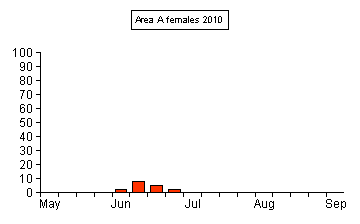
|
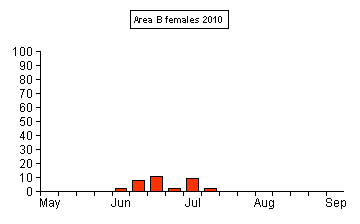
|
|
| Section A produced better numbers this year than it did in 2010, but had become totally inactive again after the last week of June. As in most sections, section A produced an earlier peak than 2010, but the area was active for seven weeks, compared to last years four. | ..... | In many ways, section B produced similar numbers to last year. But over the course of the season, this section failed to live up to our expectations and we thought initially that that numbers were down on 2010 and 2009, despite the very high on site numbers overall. However, this section did produce females within the first week of the glowing season, but the main activity period matched that of 2010. |
| Section C - Grass (sunny, south-facing)... | Section D - Grass (sunny, south-facing) | |
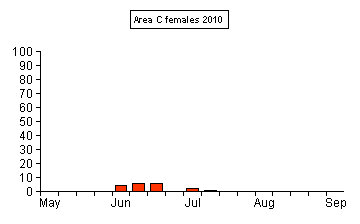
|
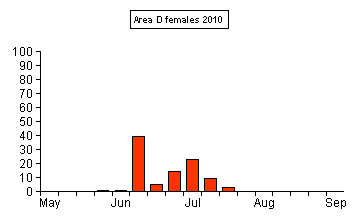
|
|
| Section C again produced low numbers of females per week from week one (May 13-20th) until the second week of July. Similar to 2010, there was no real discernable peak in numbers. | ..... | By a considerable margin, section D was the most active of all the surveyed sections in 2011. It is a large area of ground though and virtually all records came from the grass or the path edges. The graph for section D again produces a very similar looking graph to that of the maximum female counts per week for the whole of the site. A pronounced peak of just under 80 females occurred in the second week of June, much earlier than 2010. Surprisingly, section D was only active for eight weeks which is the same as 2010, yet the season lasted 14 weeks. |
| Section E - Forest path (woodland/field edge).. | Section F - Forest track (dense shade)... | |
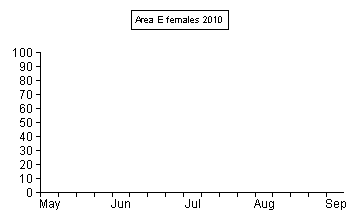 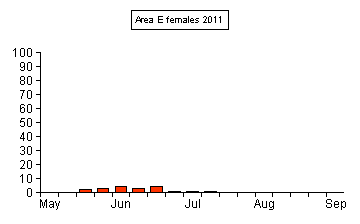 |
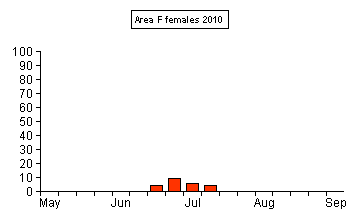
|
|
| Despite continuous surveying, no females appeared in this section during 2010, but produced an eight week period of activity in 2011. Many of the early females here, were found on the edge of the adjacent field, one of the warmest locations on site. There was some evidence of colony spread in this section this year, with two females found along a side path. | .... . |
This densely shaded section produced a couple of early females compared with 2010, but the main peak of activity occurred more or less in line with last year. Only a couple of females were found well away from the track edge under the trees in 2011 and we thought that on the whole, numbers would have been better in section F this year. |
| Section G - Forest track (dense shade)... | Section H - Forest track (partial shade) ... | |
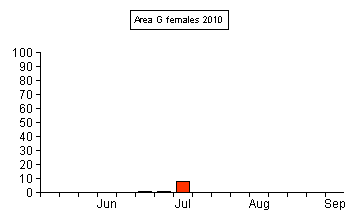
|
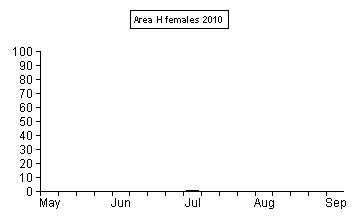
|
|
| Despite a longer season than in 2010, section G saw a contraction in the overall area in which females were located. Female 792 was responsible for the records in the second and third weeks of August. Many of the latest females came from this section. | ..... | Another poor year for this section, with just three females found on two (well spaced) dates. It could be that this section is becoming less suitable. It is quite shaded in part and it's aspect is northerly. It's also likely that larvae and resulting females in this section, have moved into it from the joining sections of F or G. |
| Section I - Minor forest path (enclosed sunny habitat) | Section J - Forest track (enclosed habitat, south facing) ... | |
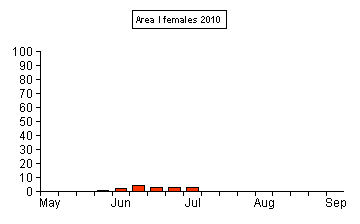
|
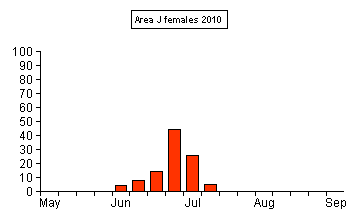
|
|
| Despite many other sections producing females earlier than 2010, the first females found in section I came a week later. This section was much more active than last year though and peaked at nearly 20 new females in the third week of June. | ..... | Section J was another very active section this year, with a much longer season than in 2010. Two of the years first three females were found within a metre of each other on May 13th and this section saw several long lived females towards the end of the season. The number of new females per week, peaked at just under 30, compared to nearly 50 in 2010. |
| Section K - Forest track (south facing).. | Section L - Forest track (flat aspect)... | |
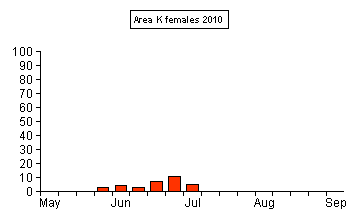
|
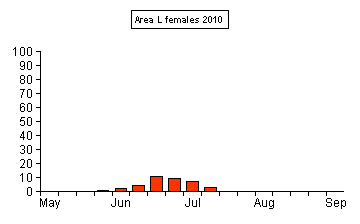
|
|
| Activity started early in what is one of the warmest sections on site. A gradual increase in the number of new females produced an earlier peak than 2010, yet there was a two week period at the site's average peak in late June, where no new females were recorded. A small number of late females did appear in July. | ..... | A generally disappointing number of females, although the first female of 2011 was found in this section. The low number of females recorded might have been a completely natural occurrence, though we felt that path levelling work in sections L and M earlier in the year, had been overly excessive and led to many larvae being buried. |
| Section M - Forest track (flat with open aspect) ... | Section N - Minor forest path (south-facing) ... | |
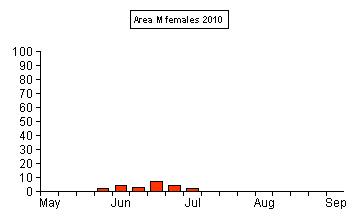
|
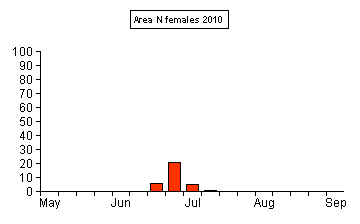
|
|
| Section M is the other section which seemed to suffer from path levelling work already mentioned in the account for section L. Although this section was more active than in 2010, most of the females recorded were actually just over the fence in the adjacent compartment, rather than along the track edges. Female emergences peaked in the second week of June and finished in early July. | ..... | Section N maintained the increase in female numbers recorded in 2010 and there was a quite considerable expansion in Glow Worm range northwards, along this southerly facing path. This expansion now means that section N is now active to the point where it meets section I and further records could come from Glow Worms moving further west into the adjacent compartment. |
| Section O - Forest track (enclosed, generally north-facing) | Section P - Forest track (north-facing). | |
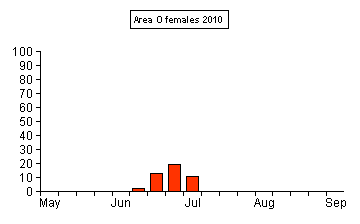
|
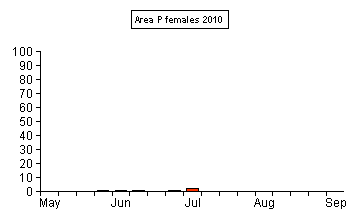
|
|
| Another section which produced a prolonged period of female activity. Despite some early records, the main peak was still in line with that achieved in the last week of June 2010 | ..... | There were just three records from this section during 2011. A female present in the first week of June, remained the only record until two appeared some three weeks later. |
| Section R - Overgrown grass path (dense shade and flat) ... | ||
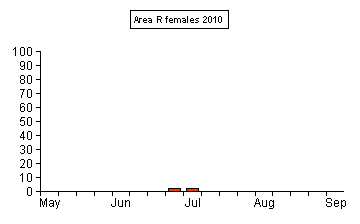
|
||
| Glow Worms were found in this heavily shaded section for the first time in 2010 and was walked daily throughout the 2011 season. Activity was well up on last year, started early and produced a pronounced peak, when many females were found in deep cover (largely Bracken and Brambles) in the last week of June. The decline in numbers after the peak was rapid, this may have been due to the very early cutting of this section on July 1st. |
| .......... | ||||||||||||||||||||||||||||||||||||||||||||||||||
| Some
short notes and observations of Female 792 in captivity The late emergence of F792 in section G on August 5th was surprising, as it occurred two weeks after F791 appeared on July 22nd. Although we had presumed that there must be late adults, none had ever been recorded in previous years despite occasional checks on site. Despite seeing nearly 2 000 females glowing, the actual lighting up process was something we had never seen, so we decided to take F792 into captivity, with the primary purpose of watching her light up in the evening. Something else we never knew, was whether females light up and then find a suitable place to glow, or whether they get into place before lighting up. There was no scientific emphasis applied to the observations and the notes were largely casual. It certainly proved very interesting though, but the following observations may not apply to the majority of females in a natural environment, or maybe at a different time of year (peak season). |
||||||||||||||||||||||||||||||||||||||||||||||||||
|
||||||||||||||||||||||||||||||||||||||||||||||||||
| .......... | ||||||||||||||||||||||||||||||||||||||||||||||||||